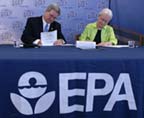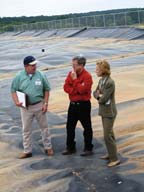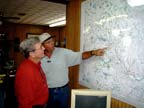Collaboration
UTEP to work with EPA to build culturally diverse workforce
 EPA and the University of Texas at El Paso (UTEP) have signed a formal memorandum of understanding, pledging their intentions to work together to build a more culturally diverse workforce for the agency.
EPA and the University of Texas at El Paso (UTEP) have signed a formal memorandum of understanding, pledging their intentions to work together to build a more culturally diverse workforce for the agency.
The new partnership is expected to significantly enhance the university’s capacity to develop environmental specialists for potential employment, while also making important contributions to EPA’s overall research and development programs.
EPA Regional Administrator Richard E. Greene and UTEP President Diana Natalicio signed the memorandum in El Paso.
Under the agreement, EPA will work with the university to provide a significant positive impact on the quality of environmental science and technical education, the relevance of UTEP research projects to EPA’s environmental and public health mission, and the number of culturally diverse students electing to pursue graduate study and research careers in areas including science, engineering, and mathematics.
The memorandum is the product of the Beyond Translation initiative launched by EPA Region 6 in 2006. This effort seeks to provide a comprehensive framework for strengthening the agency’s relationship with the Hispanic community.
More about the Beyond Translation program
Collaborative Efforts Restore Contaminated Reservoir
When the sole drinking water source for more than 18,000 people has elevated herbicide levels, what do you do? In the case of Aquilla Reservoir in Hill County, Texas, you use a combination of education and technology to get the level of chemicals under control.
The elevated levels of the herbicide atrazine were believed to be the result of its use on the corn and sorghum crops grown in the surrounding area. Studies indicate atrazine is unlikely to cause cancer in humans, but could be associated with hormonal imbalances in laboratory animals. Atrazine levels of more than five micrograms per liter were recorded at the reservoir. Immediate action was needed to keep the reservoir safe for drinking water, swimming, wading, fishing, and with a healthy aquatic ecosystem.
EPA Region 6, in cooperation with the Texas environmental agencies, initiated grants projects to educate corn and sorghum producers about the impact of atrazine use and fund monitoring of the major sub-watersheds. Additional grants helped forty corn and sorghum producers install structures and programs to reduce atrazine use and runoff, and provided technical assistance for more than one-hundred. The actions worked. Atrazine levels dropped below the allowable and have stayed there for eight years.
The project spurred development and testing of a group of practices to prevent or reduce atrazine pollution in surface water. These practices now are used in eight other watersheds in Texas.
For More Information:
Region 6 Water
Programs
Conference highlights environmental stewardship
The North Central Texas Best Sustainable Practices Conference, held in Dallas in November 2005, highlighted EPA's environmental stewardship and local municipal efforts to create and sustain clean, healthy environments. "Our region is fortunate to have outstanding communities working toward the goal of sustainability every day," said Myron Knudson, EPA Region 6 Senior Policy Advisor.
Sponsored by Sustainable Dallas, a non-profit environmental group, the city of Dallas, North Central Texas Council of Governments, Cedar Valley College, Energy Efficient Green Building Institute, the Texas Commission on Environmental Quality and EPA Region 6, the conference gave municipalities a chance to display their best efforts to preserve and enhance our environment. It also gave them a chance to learn from each other and the sponsors about proven environmental practices.
The city of Dallas was honored at the conference for addressing environmental issues through its Green Building Program. The city has more than eighteen Green projects scheduled. Dallas also has the largest environmentally responsible fleet of any municipality in the country. Other communities recognized were Arlington for preserving natural native settings, Plano for locating new housing units within walking distance of light rail transportation, and the city of Frisco for requiring Energy Star certification on all new residences.
EPA collaborates with cities, like Frisco, in the Green Building Program. The Waste-to-Energy Program, which promotes renewable energy from landfills, animal feeding operations and public treatment works, is of growing interest to communities in Region 6. Other EPA programs increase the use of renewable energy sources and reduce energy demand. "EPA has created many programs to partner with local governments and agencies," said Knudson, "because true environmental progress happens at the local level."
For more information:
Sustainable
Dallas ![]()
Practical Applications for
LEED in the City of Dallas; U.S. Green Building Council ![]()
EPA earns high Ombudsman marks
The Small Business Administration National Ombudsman's recent annual report to Congress awarded high marks to the EPA for fairly enforcing federal regulations.
A ratings, the highest, were awarded in five major categories. Quality of Response to specific small business comments by a high-level representative or the program office, and answering comments well, earned an A. Working hard to comply with its policy prohibiting retaliatory actions against complainants also earned an A, as did all the Compliance Assistance steps the Agency takes to inform and advise small businesses on the rules and on how to comply with them. Also rated A were EPA attendance at Regulatory Enforcement Fairness Hearings, as well as the Agency's work to Inform Small Businesses of their rights, including access to the Office of the National Ombudsman.
These high ratings reflect the EPA commitment to working collaboratively with federal and state agencies, industry including small business, educational institutions and others whenever possible to carry out the important mission of protecting human health and the environment.
The EPA received a C in the category of Timely Response to Comments, pointing out that while seeking a 30-day response, the Agency does concentrate on providing the Small Business Administration and the commenting small businesses with meaningful information, which often requires more time. The Agency also is reviewing all paperwork to streamline and simplify forms used across the nation. It received favorable comments for simplifying paperwork when a small firm reported a problem. Its other C came for timeliness in submitting the first Small Business Paperwork Relief Act report.
For more information:
EPA Small Business Ombudsman
RA Greene tours dairy
 Regional Administrator Richard Greene joined Texas dignitaries
in a tour to discuss strategies of phosphorus reduction in
the Bosque watershed through innovation and improved, cooperative
agriculture management practices.
Regional Administrator Richard Greene joined Texas dignitaries
in a tour to discuss strategies of phosphorus reduction in
the Bosque watershed through innovation and improved, cooperative
agriculture management practices.
 Keith
Broumley, Dairy owner, and Steel Maloney, Principal Hydrologist
of Cascade Earth Sciences, provided a comprehensive overview
and tour. Central to the Dairy's operations is a new innovative
project to reduce phosphorus in the Bosque watershed. Many
believe the project is a model for farms to cover the cost
of treating their waste by selling electricity and compost.
The 'manure-to-electricity' project captures methane and makes
electricity. The electricity can then be used or sold to the
local power grid. More >
Keith
Broumley, Dairy owner, and Steel Maloney, Principal Hydrologist
of Cascade Earth Sciences, provided a comprehensive overview
and tour. Central to the Dairy's operations is a new innovative
project to reduce phosphorus in the Bosque watershed. Many
believe the project is a model for farms to cover the cost
of treating their waste by selling electricity and compost.
The 'manure-to-electricity' project captures methane and makes
electricity. The electricity can then be used or sold to the
local power grid. More >
What is the Gulf of Mexico Program
 The Gulf of Mexico Program was formed in 1988 by the Environmental
Protection Agency as a non-regulatory, inclusive partnership
to provide a broad geographic focus on the major environmental
issues in the Gulf. The mission of the Program is “ to
facilitate collaborative actions to protect, maintain, and
restore the health and productivity of the Gulf of Mexico
in ways consistent with the economic well-being of the Region.”
The partnership includes representation from state and local
governments and the citizenry in each of the five Gulf States;
the private sector (business and industry); federal agencies
responsible for research, monitoring, environmental protection,
and natural resource management; and the academic community. More >
The Gulf of Mexico Program was formed in 1988 by the Environmental
Protection Agency as a non-regulatory, inclusive partnership
to provide a broad geographic focus on the major environmental
issues in the Gulf. The mission of the Program is “ to
facilitate collaborative actions to protect, maintain, and
restore the health and productivity of the Gulf of Mexico
in ways consistent with the economic well-being of the Region.”
The partnership includes representation from state and local
governments and the citizenry in each of the five Gulf States;
the private sector (business and industry); federal agencies
responsible for research, monitoring, environmental protection,
and natural resource management; and the academic community. More >
Mississippi Basin Facts - Click on the small map for a larger version (216K)
Our tribal partnerships recognize tribes' authority to administer their own environmental programs. Working government-to-government, EPA provides a broad range of support for tribes' environmental work. Through coordination and cooperation, advocacy, strategic planning, training and grants, EPA assists tribes in fulfilling their environmental goals. More >
State Information
Many federal environmental laws include a prominent role for states. EPA's partnerships with states have evolved far beyond shared responsibilities as co-regulators. The results are more innovative and effective protection of our environment and public health.
Today most environmental regulation and enforcement is done by states. EPA provides a comprehensive package of planning, policy, technical, analytical and information resources to support their activities. Working together allows us to address not just the effects, but also the causes of pollution. It allows us to go beyond what the law requires, using environmental regulations as a foundation for what we can accomplish, not a ceiling.
EPA continues to expand its traditional role by fostering creative collaborative solutions to complex environmental problems.

Click on the state from which you would like more information
Office
of Environmental Justice
The Agency fosters collaborative partnerships with environmental justice communities to jointly seek solutions to environmental problems. In addition to providing a broad range of support, EPA reaches out to residents to give them a larger role in environmental decisions and activities in their communities. More >
Help Protect the Environment
Report environmental violations
Report oil or chemical spills
at 800-424-8802
Resources
- Region 6 Public Information Center (800) 887-6063
- About Region 6
- Federal Register
- Contact Us
- Freedom of Information Act
- Employee Access
Additional Information
Air, Agriculture, Brownfields, Cleanup, Ecosystems, Enforcement, Environmental Justice, Grants, Laboratory, Pesticides, Superfund, Tribal, Training, Waste, Water, more topics
![[logo] US EPA](https://webarchive.library.unt.edu/eot2008/20090514115747im_/http://www.epa.gov/epafiles/images/logo_epaseal.gif)

